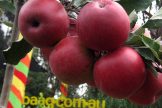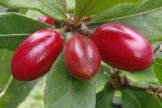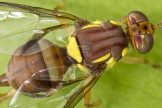
Nothing compares to the taste of a home grown, freshly picked peach or nectarine. Bursting with flavour and heavy with juice, once you have tasted peaches from your own tree you’ll never go back to canned again. As well as being tasty, peaches and nectarines are also really good for you. Both contain high levels of Vitamins A and C, as well as potassium, magnesium and beta-carotine.
Nectarines are essentially a smooth-skinned peach… that’s why we have them together on the one factsheet.
Peaches and nectarines grow really well in Melbourne as we have the perfect mild climate and a nice cold winter. If you live in an area of Melbourne that is prone to late frosts consider protecting your peaches and nectarines with shadecloth or similar as these late/spring frosts can severely damage the flowers (and impact yield).
Find a nice sunny position in your garden and ensure the soil is full of organic matter and free draining. This can be a bit of a challenge on some of our heavy clay Melbourne soils, so incorporate some gypsum and compost prior to planting and consider planting your peaches on a mound to improve drainage.
To get good large fruit thin excess fruit after fruit set and keep the tree well watered as fruit is growing. Thinning fruit also helps avoid brown rot.
For eating, peaches and nectarines are best left on the tree until ripe as their flavour is far more intense. Fruit picked while firm is fantastic for cooking and will still ripen away from the tree.

Peaches and nectarines are ideal for smaller gardens as they are generally self fertile, meaning they don’t require another tree for cross pollination. If you are really pushed for space, consider a dwarf nectarine or peach, a multi-grafted tree, or duo planting.
Peach leaf curl is endemic and all peaches and nectarines need to be sprayed with a fungicide over winter and at bud swell.
Nectazee Standard in our display garden

Of the fruit trees growing at BAAG, one that stands out as a great plant selection is the Nectazee standard at the front entrance (our north eastern parterre bed). Nectazee standards are part of the Fleming’s Trixzie miniature fruit tree range which is made up of Nectazee Nectarines, Pixzee Peaches, White and Black Cherree Cherries and Pixzee Pears. Like most other dwarf fruit trees, barring dwarf pomegranates which are ornamental anyway, these produce full sized fruit on miniature sized trees.
Regular Nectazee trees are 1.5m x 1.5m, whereas Nectazee standards, like the one we have planted here at BAAG, are grafted to 1m tall rootstock, increasing their height to 2.5m. Both edible and ornamental, these grafted standards or “lollypop” shaped trees can fill that 2-3 m height level in a garden bed (hard to do for a tree!), whilst allowing you enough room to grow small shrubs and ground covers underneath. Another endearing characteristic of these trees is their ability to hide their treasure, surprising you with their gleaming orbs when you peek underneath their long weeping leaves (pictured). I suppose the only drawback that we’ve found of ours is that it doesn’t seem resistant to brown rot, so remember to spray as you would for the fungal disease peach leaf curl and dispose of any mummified fruit if your tree does get affected and you should be right.
The best time to plant these trees is in during bare root season or in winter when the trees are dormant, so to get a Nectazee standard in your garden don’t forget to include one in your winter planting schedule.
 |
 |





